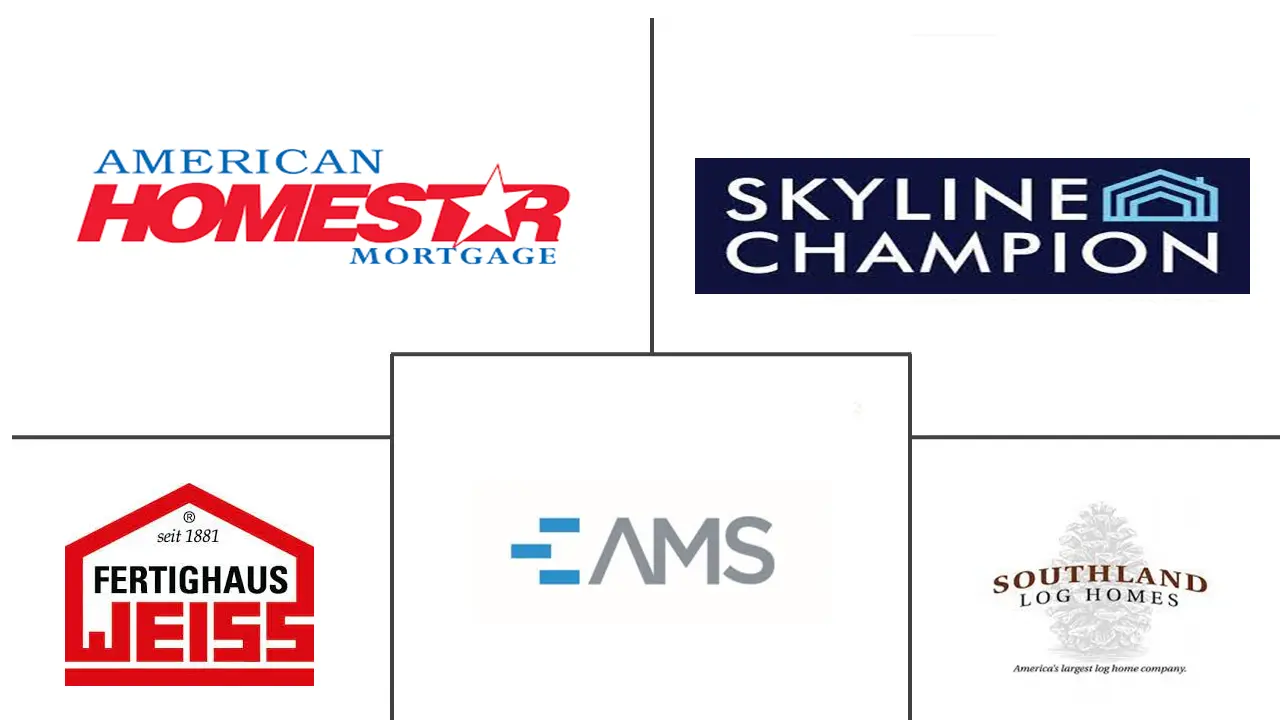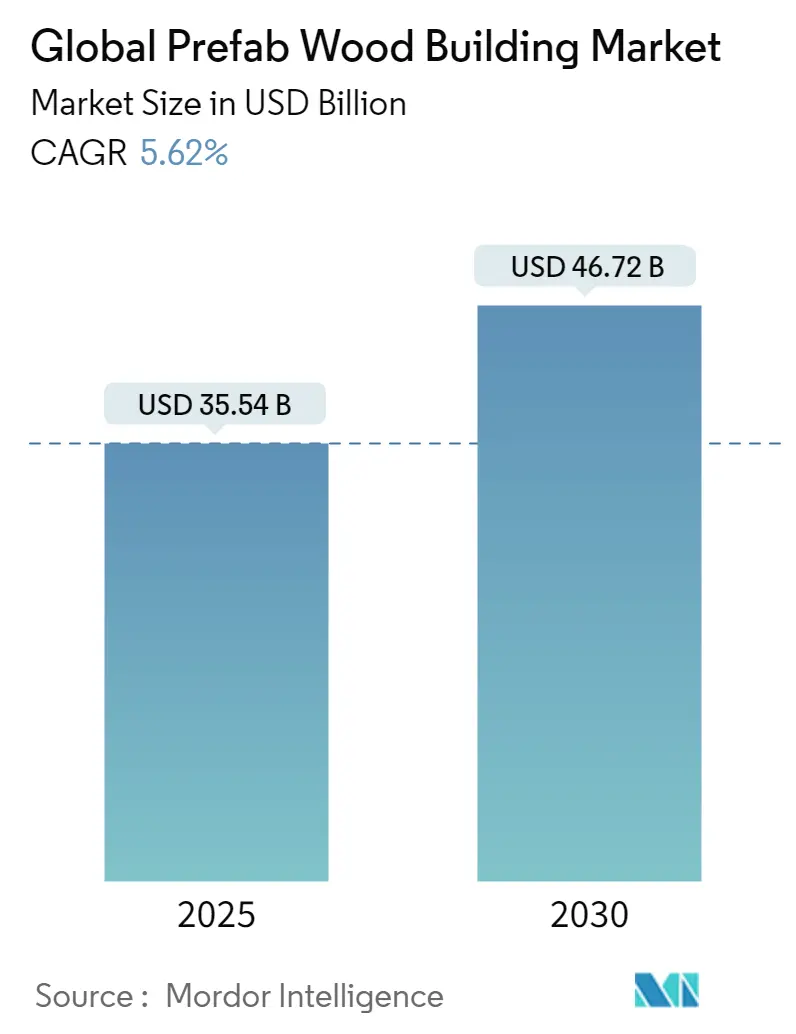
Global Prefab Wood Building Market Analysis by Mordor Intelligence
The Global Prefab Wood Building Market size is estimated at USD 35.54 billion in 2025, and is expected to reach USD 46.72 billion by 2030, at a CAGR of 5.62% during the forecast period (2025-2030).
- Architects worldwide are increasingly turning to post and beam and glued-laminated timbers, making prefabricated wooden buildings some of the quickest and easiest to construct. Despite being an annual, wood continues to sequester carbon dioxide even after being cut. This characteristic makes wood not just a construction material but a potent ally in the fight against climate change.
- Construction activities and building operations are responsible for over 40% of the carbon emissions fueling global warming. Simultaneously, 1.6 billion people reside in inadequate housing, with a staggering 100 million lacking shelter altogether. Both in Australia and worldwide, the housing crisis remains a pressing, unresolved challenge. Yet, prefabricated building technology emerges as a beacon of hope, offering solutions to this dual dilemma.
- The wood frame system enjoys widespread adoption in nations like the United States, Japan, and Germany. Highlighting this trend, the Parkside Carvoeira building in Florianópolis, recognized by ARch Daily, proudly holds the title of Brazil's tallest wood frame building.
- Canadian Wood, hailing from sustainably managed forests in British Columbia (B.C.), stands as a trusted supplier of wooden products in the Indian market. With options like Spruce-Pine-Fir (SPF), Douglas-fir, Western Hemlock, Western Red Cedar, and Yellow Cedar, turning any vision into reality becomes feasible.
- While the demand for prefabricated conventional homes has surged, log homes have emerged as a significant and growing segment of the industry. In the late 1990s, log homes constituted roughly 7% of all custom homes in the U.S., and exports of these prefabricated log homes witnessed a notable uptick. Much like modular homes, log dwellings have seen a rise in affluence. However, they consume 10% to 20% more wood than traditionally constructed houses, making their preferred wood increasingly scarce.
Global Prefab Wood Building Market Trends and Insights
Canada Leads the Charge in Prefab Wood Building Market
The prefab wood building market in Canada is on the rise, driven predominantly by the growing adoption of advanced panel systems. Leading this charge are materials such as Cross-Laminated Timber (CLT), Nail-Laminated Timber (NLT), Dowel-Laminated Timber (DLT), and Glue-Laminated Timber (GLT) columns and beams. Renowned for their sustainability and structural integrity, these materials have swiftly become the preferred choice for builders and architects across the country.
Consider the Red Deer Polytechnic Student Residence in Red Deer, Alberta, spotlighted by Construction Business in October 2024. This Canadian residential endeavor, executed via an integrated project delivery (IPD) model, utilized a collaborative 'Choosing by Advantages' (CBA) approach. The team evaluated concrete, steel, wood, and composite systems to determine the best structural fit. The outcome was a five-storey midrise hybrid building, featuring glue-laminated timber (GLT) posts and beams as its structural backbone, GLT panels for the floor and roof, and dimensional lumber for load-bearing walls, shearwalls, and interior partitions. This deliberate selection underscored the growing significance of prefab wood solutions in Canadian construction, delivering maximum benefits at minimal costs.
In Vancouver, British Columbia, another hybrid project, Vienna House, is underscoring the prominence of prefab wood systems in the Canadian market. As reported by Construction Business in October 2024, this project is set to be a near zero-emissions rental apartment community. By choosing Cross-Laminated Timber (CLT) over GLT, Vienna House is integrating CLT floor and ceiling panels with prefabricated light frame wall construction. The design not only champions eco-friendliness but also incorporates seismic reinforcing tension rods in the shearwall system, acknowledging its high seismic zone location. Once finalized, Vienna House will offer 123 units, including 56 family units, catering to a diverse range from shelter and low-income to average market rentals. This initiative underscores the versatility and efficiency of prefab wood systems in meeting varied construction demands within Canada.
In conclusion, the prefab wood building market in Canada is evolving rapidly, with advanced panel systems like CLT and GLT playing a pivotal role. These materials not only bolster structural efficiency but also align with Canada's sustainability objectives, making them integral to modern construction practices. Projects such as the Red Deer Polytechnic Student Residence and Vienna House highlight the adaptability, cost-effectiveness, and environmental consciousness of prefab wood systems, driving the market's growth across Canada in 2024 and beyond.
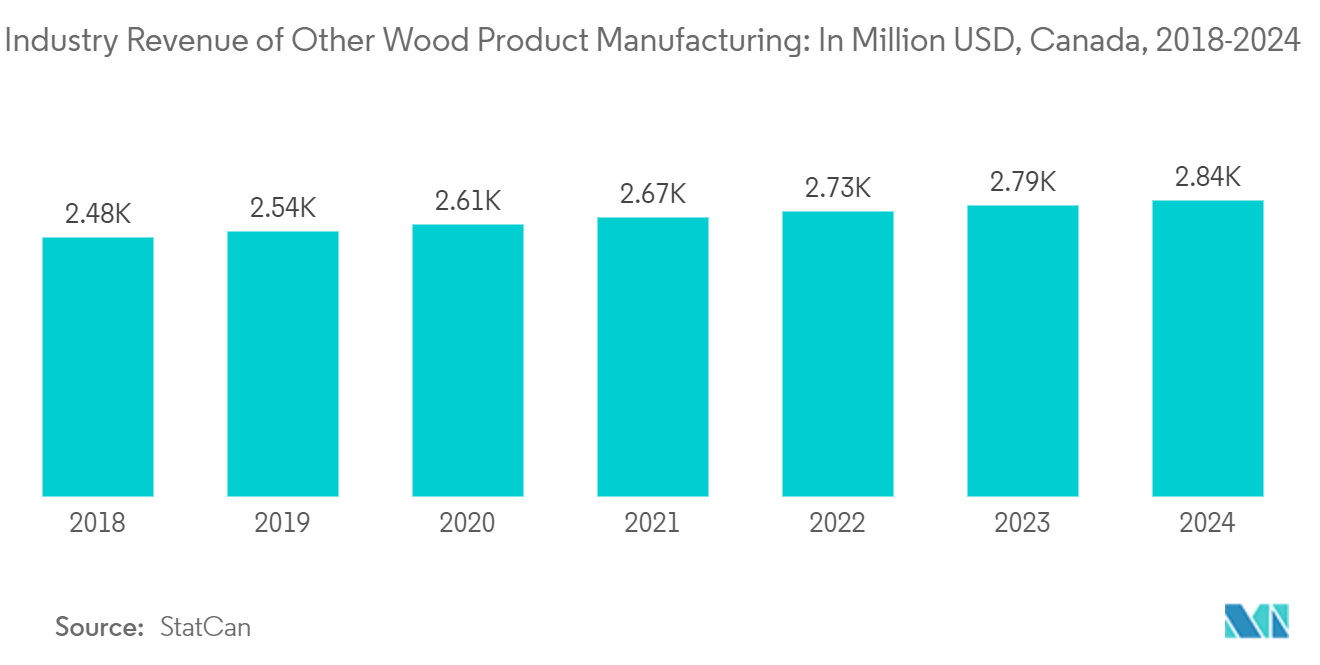
Panel Systems Feuling the Market
With over 1,600 organizations and a workforce exceeding 231,600, the global prefab wood building market is witnessing a slight annual growth rate dip of 1.28%. Yet, in the last five years, the market has welcomed over 300 new companies, each averaging an employment of 18 individuals as reported by Industry Associations.
Prefab wood panel systems, including those used in data centers, are increasingly utilizing materials like cross-laminated timber (CLT), a fire-resistant, prefabricated wood material. For instance, as reported by DCD, October 2024, Microsoft has adopted a combination of wood, steel, and concrete in its data centers, a move projected to reduce the facilities' embodied carbon footprint by 35% compared to traditional steel construction and by 65% compared to standard precast concrete.
While CLT is widely used as a building material globally, its application in the data center sector remains limited. In Sweden, EcoDataCenter and Boden Type are pioneering the use of CLT in their data centers, a trend echoed by several facilities in Iceland. Additionally, Vertiv has introduced its own prefabricated wooden data center module. While EcoDataCenter's construction leans heavily on wood, CLT's offsite prefabrication allows for swifter and safer installation than the corrugated steel prevalent in large commercial structures. Though CLT may elevate material costs by 5-10% over traditional timber, the savings from a shortened construction timeline can offset this premium.
In conclusion, the global prefab wood building market, particularly in the panel systems segment, is evolving with innovative materials like CLT. Despite challenges such as higher material costs, the benefits of reduced construction time, sustainability, and safety are driving its adoption across various sectors, including data centers. This trend highlights the market's potential for growth and its role in advancing eco-friendly construction practices.
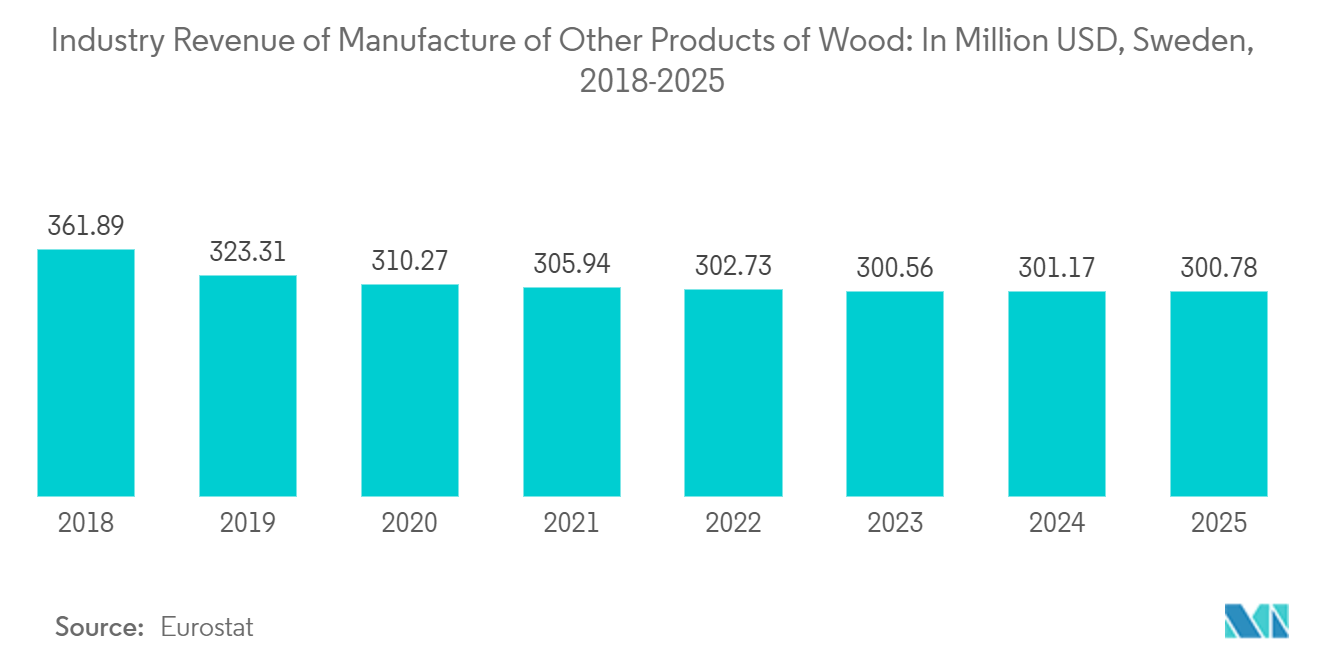
Competitive Landscape
The market for prefabricated wood buildings is fragmented, with several local and foreign firms. The competition among these players is intense. Customers want constant improvements and updates in construction, therefore the fast-changing technical environment is predicted to harm providers. To maintain a strong industry presence, companies are changing and refining their distinctive value offering.
Developed nations, including the United States and Western Europe, exhibit pronounced market concentration. In contrast, developing countries like China and India are witnessing the sector's nascent stages. Major corporations leverage economies of scale in both purchasing and marketing. Meanwhile, smaller enterprises carve out their niche by honing in on local markets or offering specialized items.
Some of the major players are Skyline Champion, American Homestar, Southland Log Homes, Fertighaus Weiss, American Modular Systems, Honkarakenne, and Matsushima Rinko.
Global Prefab Wood Building Industry Leaders
-
Skyline Champion
-
American Homestar
-
Southland Log Homes
-
Fertighaus Weiss
-
American Modular Systems
- *Disclaimer: Major Players sorted in no particular order
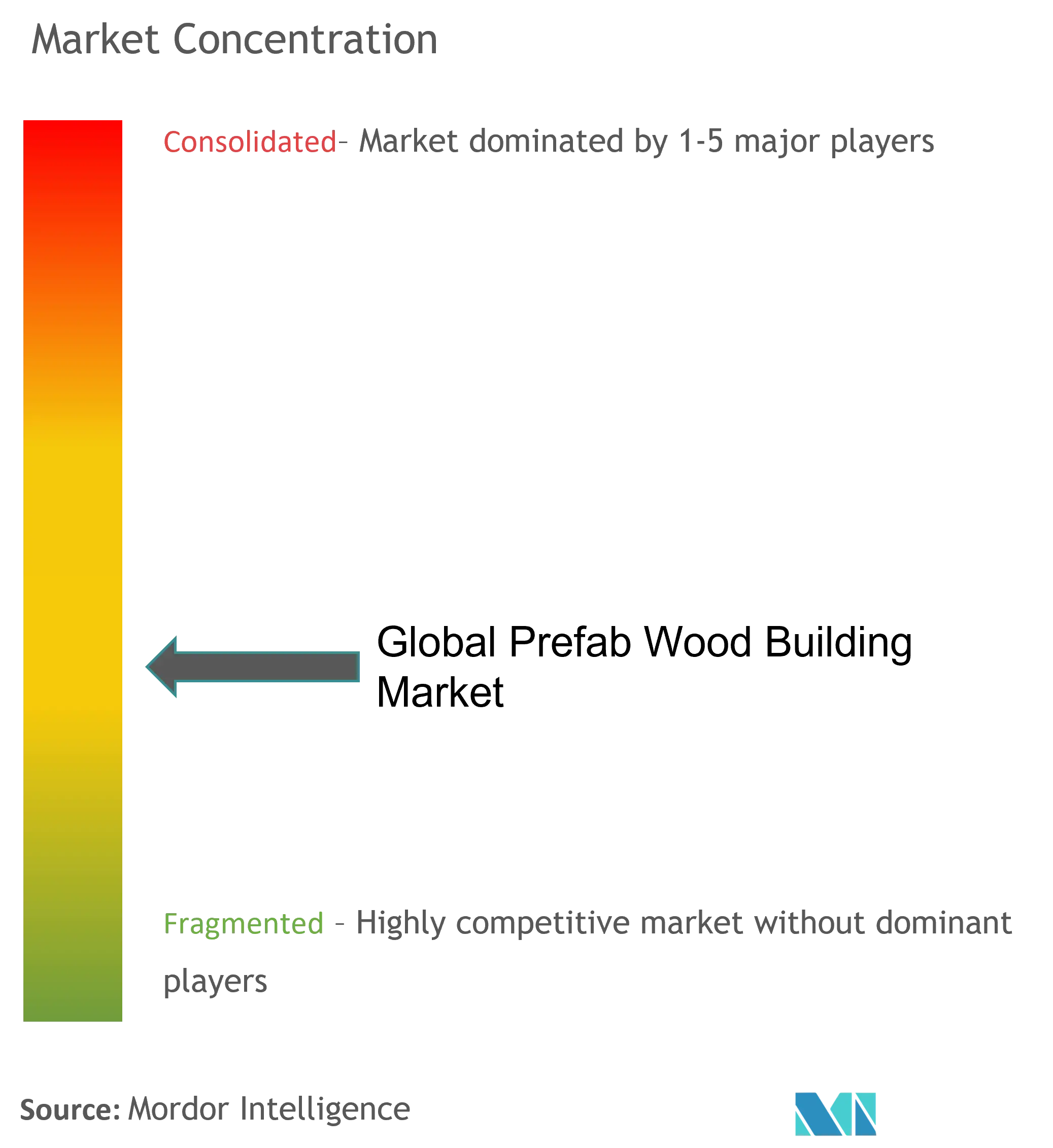
Recent Industry Developments
- June 2024: The No Footprint House – NFH is a German architect Oliver Schütte prefabricated house that seeks to solve the dwellings problems facing contemporary societies. It is an energy efficient contemporary home, signed by the photorealistic renderer, that does not use any resources that has a negative impact on the environment.
- January 2024: In the context of the global prefabricated wood building market, VUILD has unveiled a tower-like sauna in Teshikaga, Hokkaido, crafted from curving modules reminiscent of a LEGO stack. The sauna's distinctive free-form surfaces, both inside and out, were meticulously crafted from Cypress wood blocks. These blocks, processed in three dimensions, were shaped using advanced 5-axis CNC machinery, showcasing the potential of prefabrication technologies in the wood building sector.
Global Prefab Wood Building Market Report Scope
Prefabricated wood construction kits, similar to life-sized Legos, are constructed out of prefabricated components that are supplied and installed on-site. This is most commonly accomplished by the use of prefabricated panels that may create complete portions of a building, such as roofing components or structure (ceiling, decking, and beams), building structure (wall panels, beams, columns, and shear paneling), and even glazing packages.
The Global Prefab Wood Building Market is segmented by panel systems (Cross-Laminated Timber (CLT) panels, Nail-Laminated Timber (NLT) panels, Dowel-Laminated Timber (DLT) panels, and Glue-Laminated Timber (GLT) columns and beams), by application (single family residential, multi-family residential, office, hospitality, and others), by geography(North America, Latin America, Asia-Pacific, Middle East, and Africa, Europe and Rest of the World). The report offers market size and forecasts for the Prefab Wood Building Market in value (USD) for all the above segments..
Furthermore, this report covers market insights, such as market dynamics, drivers, restraints, opportunities, technological innovation, its impact, porter's five forces analysis, and the impact of geopolitical issues and pandemic on the market. In addition, the report also provides company profiles to understand the competitive landscape of the market.
| Cross-laminated timber (CLT) panels |
| Nail-laminated timber (NLT) panels |
| Dowel-laminated timber (DLT) panels |
| Glue-laminated timber (GLT) columns and beams |
| Single Family Residential |
| Multi-family Residential |
| Office |
| Hospitality |
| Others |
| By Panel Systems | Cross-laminated timber (CLT) panels |
| Nail-laminated timber (NLT) panels | |
| Dowel-laminated timber (DLT) panels | |
| Glue-laminated timber (GLT) columns and beams | |
| By Application | Single Family Residential |
| Multi-family Residential | |
| Office | |
| Hospitality | |
| Others |
Key Questions Answered in the Report
How big is the Global Prefab Wood Building Market?
The Global Prefab Wood Building Market size is expected to reach USD 35.54 billion in 2025 and grow at a CAGR of 5.62% to reach USD 46.72 billion by 2030.
What is the current Global Prefab Wood Building Market size?
In 2025, the Global Prefab Wood Building Market size is expected to reach USD 35.54 billion.
Who are the key players in Global Prefab Wood Building Market?
Skyline Champion, American Homestar, Southland Log Homes, Fertighaus Weiss and American Modular Systems are the major companies operating in the Global Prefab Wood Building Market.
Which is the fastest growing region in Global Prefab Wood Building Market?
Asia-Pacific is estimated to grow at the highest CAGR over the forecast period (2025-2030).
Which region has the biggest share in Global Prefab Wood Building Market?
In 2025, the North America accounts for the largest market share in Global Prefab Wood Building Market.
What years does this Global Prefab Wood Building Market cover, and what was the market size in 2024?
In 2024, the Global Prefab Wood Building Market size was estimated at USD 33.54 billion. The report covers the Global Prefab Wood Building Market historical market size for years: 2020, 2021, 2022, 2023 and 2024. The report also forecasts the Global Prefab Wood Building Market size for years: 2025, 2026, 2027, 2028, 2029 and 2030.
Page last updated on:
Global Prefab Wood Building Market Report
Statistics for the 2025 Global Prefab Wood Building market share, size and revenue growth rate, created by Mordor Intelligence™ Industry Reports. Global Prefab Wood Building analysis includes a market forecast outlook for 2025 to 2030 and historical overview. Get a sample of this industry analysis as a free report PDF download.
